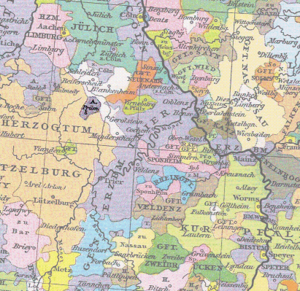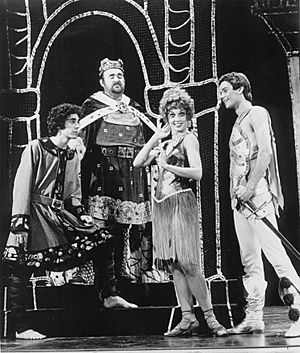Pepin the Hunchback facts for kids
Quick facts for kids Pepin the Hunchback |
|
|---|---|
| Born | ca. 768 or 769 Frankish Empire |
| Died | 811 (aged 42) Prüm |
| Dynasty | Carolingian |
| Father | Charlemagne |
| Mother | Himiltrude |
Pepin, or Pippin the Hunchback (French: Pépin le Bossu, German: Pippin der Buckelige; c. 768 / 769 – 811) was a Frankish prince. He was the eldest son of Charlemagne and noblewoman Himiltrude. He developed a humped back after birth, leading early medieval historians to give him the epithet "hunchback". He lived with his father's court after Charlemagne dismissed his mother and took another wife, Hildegard. Around 781, Pepin's half brother Carloman was rechristened as "Pepin of Italy"—a step that may have signaled Charlemagne's decision to disinherit the elder Pepin, for a variety of possible reasons. In 792, Pepin the Hunchback revolted against his father with a group of leading Frankish nobles, but the plot was discovered and put down before the conspiracy could put it into action. Charlemagne commuted Pepin's death sentence, having him tonsured and exiled to the monastery of Prüm instead. Since his death in 811, Pepin has been the subject of numerous works of historical fiction.
Contents
Debate over legitimacy
The circumstances of Pepin's birth remain unclear to modern scholars, especially regarding the legitimacy of his mother's union to Charles. Most Carolingian-era sources dismiss Charles' first union as illegitimate.
It is possible that the union of Charlemagne and Himiltrude was a Germanic form of marriage with fewer obligations than the sacramental marriage of the Church. Another possibility is that Charles and Himiltrude were not fully, legally married by the church, or they simply got married after Pepin was born. What is known fairly certainly is that Charles fathered a son with a woman named Himiltrude, with whom he may or may not have been married.
Name
The nature of Pepin's birth is further illuminated by an understanding of his name and the customs of naming present during this time. Carolingian aristocrats frequently named newborn children after successful ancestors. This tradition was more than a mere homage to dead relatives—it seems that the Carolingians saw naming customs as a way to help children assume the historical roles of their eponymous ancestors.
Charlemagne's dynasty was dominated by the name "Pepin": it had been Charles' father's name, as well as that of several other members of the royal line. In fact, Charles' brother and political rival Carloman named his firstborn Pepin before Charles was even married. Charles, then, was naturally inclined to name his first son "Pepin"—announcing his own dynastic ambitions, clearing the ground for the eventual recognition of his son as emperor. However, Notker the Stammerer, writing long after Pepin's death, suggests that it was Himiltrude (Pepin's mother), and not Charles, who gave Pepin his name.
Disfavour
Pepin apparently continued to live at his father's court even after Charlemagne dismissed Pepin's mother Himiltrude to marry Desiderata, the daughter of the Lombard king, around 770. Only after Charlemagne's marriage to Hildegard, and the birth of new male heirs like Charles the Younger (772) and Carloman (773), did Pepin's position seem to become more precarious. In either 780 or 781, Charles had the young Carloman baptized by Pope Hadrian in Rome, renaming him Pepin. The Poeta Saxo, a 9th-century Latin poet who records the events of Charlemagne's reign, tells us that while Charlemagne "attended the solemnties of Easter the venerable Pope administered soul-saving baptism to Charles' son Pepin [formerly Carloman]." Charles had added another, more fit Pepin to his lineage—an apparent snub that many historians have interpreted as the beginning of Pepin the Hunchback's disinheritance. However, a dearth of documents and credible contemporary historians leaves the question up for debate, and some have even argued that Pepin retained a full stake in the inheritance of the kingdom right up until his rebellion in 792.
Late disinheritance theory
Charlemagne was extremely conscious of the notions of succession and inheritance during his lifetime, even refusing to marry off his daughters to the Frankish nobility. This quirk scandalized later contemporary historians ("Strange to say," Einhard writes, "he never wanted to give any one of them in marriage to anybody") and probably reflects Charles' reluctance to leave problematic heirs that could interfere with a peaceful succession after his death. But in spite of all the potential difficulties that Pepin presented for the succession—particularly his dubious birth and problematic deformity—sources suggest that Charlemagne treated him with affection and even respect. Even after Carloman was rechristened "Pepin", Charlemagne maintained the older Pepin at his court, right alongside Charles the Younger, one of Charlemagne's sons by Hildegard. Charlemagne named Charles the Younger "King of the Franks" when he divided his kingdom in 806, and to some historians this suggests that Pepin the Hunchback was also being groomed for future kingship, perhaps for the "lion's share" of Francia, before his rebellion in 792. According to historian Janet Nelson, the rechristening of Carloman probably had more to do with satisfying "political interests outside [Charlemagne's] family," than it did with disinheriting the original Pepin. Particularly, the christening of an Italian king named Pepin reaffirmed the Franks' historical commitment to the papacy: it was probably meant to evoke the pro-papal policies of Charles' father Pepin the Short.
Early disinheritance theory
Other historians see the baptism of Carloman as a repudiation of Pepin, and trace the systematic rejection of Pepin's claims to the throne in the subsequent actions of Charlemagne and his court. Walter Goffart argues that the Gesta Episcoporum Mettensium, written by Paul the Deacon in the mid 780s before Pepin's revolt, reveals the "succession plan" of Charlemagne and his court—a plan that left no room for a hunchbacked king. According to Goffart, Paul uses his history of the ancestry of Charlemagne as an allegory for the current succession by depicting the Frankish kingship as a "birthright" handed down from a father to only one son, like those passed down among Biblical patriarchs. Like Esau, Pepin was rejected in favor of his younger brothers: Charlemagne, "like Isaac in the Bible, had no more than one blessing to bestow." Goffart and like-minded historians even speculate that Charlemagne and his court offered Pepin a sort of quid pro quo: in return for surrendering his claim to the throne, "the Hunchback may have been promised that he would become bishop of Metz."
There are also more concrete reasons for believing that Pepin was passed over for the succession. While he apparently remained at court with Charlemagne's third wife and new Queen Fastrada, his half-brother Charles the Younger joined his father on important campaigns, and even led large detachments of troops. As Goffart puts it, Charlemagne increasingly tasked "Charles the Younger to responsible commands, while leaving Pepin in the shade."
Finally, changing standards of marriage might have undermined Pepin's claims to the throne. Charlemagne's intimate relationships, with both wives and concubines, drew much criticism from his contemporaries—a monk from Reichenau even reported a "vision" he had in which he saw Charlemagne being gruesomely punished in purgatory for his marital sins. Indeed, the medieval historians who dismissed Pepin's mother as a concubine were often the same intellectuals and religious reformers who pushed for the imposition of orthodox Catholic practices throughout the Frankish domains, and the abandonment of old pre-Christian customs. Such reformers would have rejected the morality of friedelehe outright, even if Himiltrude was technically Charlemagne's legal wife under old Germanic law. Some historians have argued that this morality shift—a move to more orthodox Catholic definitions of marriage—helped push Pepin into the background. If Charles wanted to impose Catholic notions of orthodoxy on his domains, then he needed to abandon Pepin—the incarnate symbol of what was at best a pre-Christian variety of marriage and at worst, an un-Christian concubinage. Moreover, the notoriously "uxorious" Charles might have bowed to pressure from his new wife Hildegard, who wanted her own son to enjoy the most legitimate claim to the throne.
Revolt
In 792, Pepin the Hunchback attempted to overthrow his father with the help of a faction of discontented Frankish nobles. The plan however was discovered and thwarted before it could be put into action.
The court and king found all of the conspirators guilty, confiscated their lands and condemned them to death as punishment. However, some of the conspirators walked away with their lives, Pepin included. Charles was likely unwilling to put to death his first-born son, who still seemed to hold some of his father's affection.
Monastic life and death
Pepin became a monk, and settled at the abbey of Prüm. Located near the confluence of the Rhine and Moselle rivers, just north of modern-day Luxembourg, Prüm was far from the heart of Charles' empire, and therefore a fitting site for exile. Pepin spent his remaining years there, sheltered from political intrigues and upheavals.
In 806, Charles, careful to ensure a smooth transition of power upon his death, issued the divisio regnorum, a royal decree that divided the lands of his kingdom into three separate territories, which would be divided among his three "remaining" sons (though Pepin the Hunchback was still alive at the time): Charles the Younger, Pepin (Carloman), and Louis. There is some ambivalence as to whether Pepin the Hunchback's exclusion from the divisio was a result of the Revolt of 792 or due to the supposed and aforementioned illegitimate nature of his birth.
Sometime around 811, Pepin died while at Prüm, likely from plague. Historians dispute the actual date, but evidence seem to suggest it ranged from 810 to 811, with the Royal Frankish Annals recording his death as 8 July 810.
In fiction and popular culture
The 1972 Broadway musical hit, Pippin, by Stephen Schwartz and Roger O. Hirson, is loosely based on the Pippin the Hunchback of history. The musical was well-received; its original New York production ran for almost five years and won multiple Tony awards: Best Direction of a Musical (Bob Fosse), Best Choreography (Bob Fosse), Best Leading Actor in a Musical (Ben Vereen), among others. In 2013, it returned to Broadway in a major well-acclaimed revival, which also won many Tonys, including Best Revival of a Musical, Best Direction of a Musical (Diane Paulus), Best Performance by a Leading Actress (Patina Miller, playing the role previously played by Tony Award winner Ben Vereen) and Best Performance by a Featured Actress (Andrea Martin).
In her 1959 children's novel Son of Charlemagne, the author Barbara Willard tells the story of Charlemagne's family in a historical-fictional style by fleshing out the details of more historical accounts (likely, Einhard was a major source). In such scenes as Carloman's baptism, "Carl" expresses distress as he realizes that he has been renamed Pepin and takes his older half-brother's place.
The short story by Alexandre Dumas, "Episodes from Pepin et Charlemagne", has been incorrectly cited as being about Pepin the Hunchback. In fact, the story is about his namesake and grandfather, Charles's father Pepin. The story tells how Pepin met his bride Berthe (which was the name of the wife of Pepin of Italy and so it is possible Dumas was slightly confused by the redundant names in the history) and is not about the hunchbacked prince.
The DC comic Arak, Son of Thunder (1981–1985) was set in the time of Charlemagne and featured Pepin (as Pip) in its contemporaneous backup strip, Valda the Iron Maiden.
See also
 In Spanish: Pipino el Jorobado para niños
In Spanish: Pipino el Jorobado para niños




